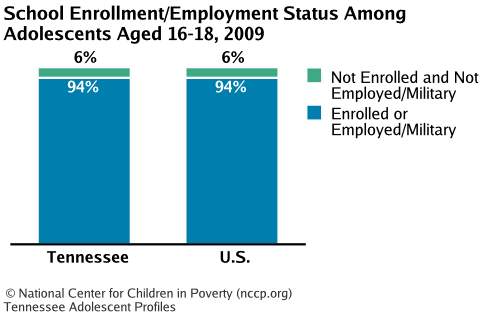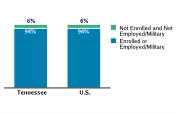| Violence and Injury Prevention | Youth Development |
State Choices to Promote Access
Educational Attainment
- Set minimum compulsory completion age of high school at 18 or older [2010]2
- Provide funding for after-school/out-of-school time programs for youth [2010]3
- Fund mentoring initiatives [2010]4
- Allow undocumented immigrants to receive in-state tuition [2008]5
- Provide Educational and Training Vouchers or tuition waivers for foster youth seeking post-secondary education [2010]6
Transition to Adulthood
- Fund a career and technical education office within its education department [2010]7
State Choices to Promote Quality
Educational Attainment
- Fund afterschool/out-of-school time program evaluation initiative for youth [2010]8
- Use the Compact Rate formula to measure graduation rate [2010]9
Transition to Adulthood
- Have a career and technical education office that partners with communities to offer internship programs [2010]10
- Collaborate with private sector to expand job opportunities for youth aging out of foster care [2010]7
- Provide aftercare services to ease transition from juvenile justice system, including education, life skills training, vocational training, and counseling services [2010]7
- Allow foster youth aging out of system to voluntarily retain state guardianship until age 21 [2009]11
Law and Legislation
- Have a legislative youth advisory council or commission [2009]12
Data Notes and Sources
Last Updated: June 1, 2011
These state profiles are part of the Improving the Odds for Adolescents project, which is supported by a generous grant from The Atlantic Philanthropies. Contact us with questions or to update your state profile.
- State data were calculated from the Annual Social and Economic Supplement (the March supplement) of the Current Population Survey from 2007, 2008, and 2009, representing information from calendar years 2006, 2007, and 2008. NCCP averaged three years of data because of small sample sizes in less populated states. The national data were calculated from the 2009 data, representing information from the previous calendar year.
- Education Commission of the States. 2010. Compulsory School Age Requirements. Accessed Feb. 14, 2011, from www.ecs.org/clearinghouse/86/62/8662.pdf.
- U.S. Department of Health and Human Services. Administration for Children and Families. Afterschool Investments, State Afterschool Profile(s). Accessed Aug. 9, 2010, from nccic.acf.hhs.gov/afterschool/statep.html.
Personal communication with state agency: includes private letters, memos, some electronic communication (i.e. email, personal interviews, or telephone conversations). - Administration for Children and Families: Child Care Bureau. Afterschool Investments - Settings and Activities: Mentoring. Accessed May 5, 2010, from www.nccic.acf.hhs.gov/afterschool/results.php?category=8&state=.
- Education Commission of the States. 2008. In-state Tuition for Undocumented Immigrants. Accessed Aug. 3, 2010, from www.ecs.org/clearinghouse/75/53/7553.pdf.
- National Resource Center for Youth Development: State by State Fact Pages. Accessed April 28, 2010, from www.nrcyd.ou.edu/state-pages/search/tuition_waiver.
State ETV Programs. 2010. ETV Program website. Accessed February 11, 2011, from www.statevoucher.org/state_not_in_service.shtml. - Personal communication with state agency: includes private letters, memos, some electronic communication (i.e. email, personal interviews, or telephone conversations).
- Data unavailable for many states.
Measuring Results: Research and Program Evaluation. Administration for Children and Families. U.S. Department of Health & Human Services website. Accessed June 22, 2010, from nccic.org/afterschool/results.php?category=41&state=. - Curran, Bridget; Reyna, Ryan. 2010. Implementing Graduation Counts: State Progress to Date, 2010. National Governors Association: Center for Best Practices. Accessed Feb. 14, 2011, from www.nga.org/Files/pdf/1012GRADCOUNTSPROGRESS.PDF.
- This also includes apprenticeships, job shadowing, and work-based learning opportunities.
Personal communication with state agency: includes private letters, memos, some electronic communication (i.e. email, personal interviews, or telephone conversations). - Status subject to changes due to the provision in the Fostering Connections to Success Act which will allow states to claim Title IV-E funding for foster youth until age 21, beginning Oct. 2010.
Casey Family Programs. State Child Welfare Policy Database. Accessed Aug. 9, 2010, from www.childwelfarepolicy.org/pages/map.cfm.
Dworsky, Amy; Havlicek, Judy. 2009. Review of State Policies and Programs to Support Young People Transitioning Out of Foster Care. Chicago: Chapin Hall at the University of Chicago. - National Conference of State Legislatures. Statewide Legislative Youth Advisory Councils. Accessed Oct. 8, 2010, from www.ncsl.org/Portals/1/documents/cyf/Councils_grid.pdf.
Individual state legislature homepages.


